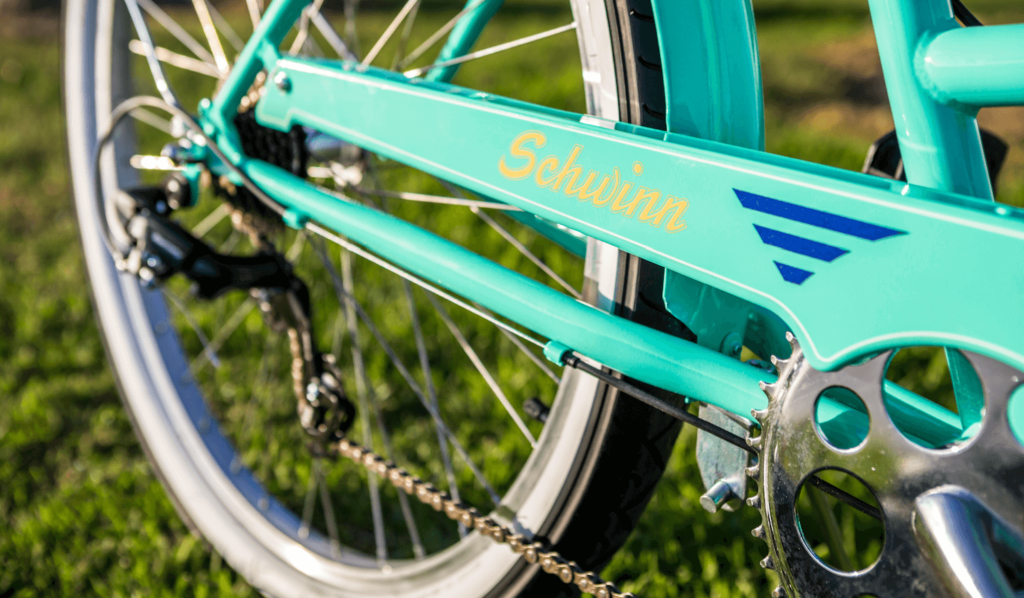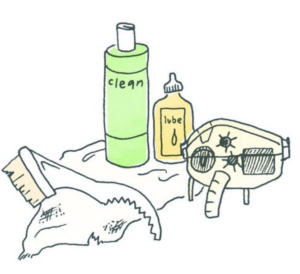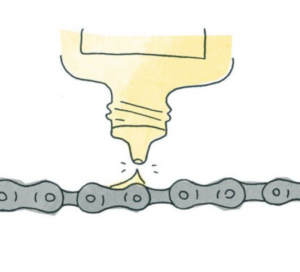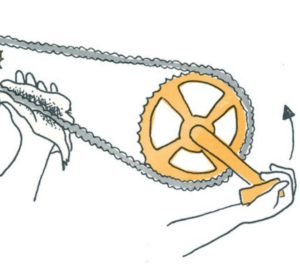Autumn Gear Guide
Find inspiration in our Gear Guide that will keep you out on your bike through wind or rain.
Download NowBasic chain care is worth the effort, surprisingly simple and neither time- nor money-consuming. And a little work goes a long way towards improving your chain’s lifespan and performance.

Ever ignored a dry, squeaking chain and ridden for months with your bike chirping like a nest of hungry eaglets? You’ll be happy to learn that basic chain care is worth the effort, surprisingly simple and neither time- nor money-consuming. And a little work goes a long way towards improving your chain’s lifespan and performance.
What You’ll Need:
– A chain-friendly degreasing solvent (like Simple Green or a citrus degreaser; ask your bike shop for recommendations)
– Old toothbrush or cotton rags (torn-up old cotton T-shirts, sheets or diapers are great)
– A good chain lube for your riding environment
Optional Items:
– A gear-cleaning brush for cleaning the cogs, derailleur and sprockets
– A repair stand
– Latex or rubber gloves to keep your hands clean
– A chain-cleaning tool

Step 1. Clean It

Step 2. Oil It

Step 3. Wipe It Off (Illustrated by Jana Kinsman)
1. Clean It
Choose a workspace where you can make a mess (outdoors, indoors on a drop cloth or at your community bike shop). If you have a repair stand, put your bike on it; if you don’t, either prop the front wheel securely so that the bike stands alone or flip the bike upside down and let it rest securely on its handlebars and seat (protect your seat from scuffs and dirt by setting it on a rag).
When you clean your chain, go ahead and clean your rear cogs (the cluster of gears on your rear wheel) and your rear derailleur pulleys (the star-shaped things the chain zigzags through), too – if those are really gunked up, your chain will get dirty that much quicker once you’re finished. There’s a gear-cleaning brush made especially for doing this: one side has toothbrush-like bristles for scrubbing, and the other is curved and toothy, to scoop gunk from between the cogs. If you don’t have this, just use a rag and old toothbrush with some cleansing solvent, and get as much dirt off as you can (“flossing” the rear gears with a rag works great).
Now, the chain. If you want, you can buy or borrow a chain-cleaning tool to do some of the dirty work. This tool is a little box with brushes and rollers inside: you pour solvent in, clip the box onto the lower section of your chain, hold the box in place and then backpedal the whole chain through it several times. The rollers and bristles run your chain through a solvent bath. After that, you empty out the tool and repeat the process using soapy water instead of solvent; then, wipe the chain dry with a clean rag.
If you don’t have a chain-cleaning tool, the old-school method costs less and works perfectly well. Just spray some bike-friendly cleanser onto a rag. Grip a segment of the chain with the cleanser-soaked rag and hold it gently but firmly. Now, use your free hand to pedal backwards, until the entirety of the chain has been run through the rag and wiped off. Then, repeat.
2. Oil Your Bike Chain
Take a good chain lubricant for your riding environment (see “Oils” sidebar) and drip oil evenly over the chain. The easiest way to do this is to let the oil drip steadily onto a fixed point while backpedaling, so the entire chain gets saturated. Ideally, use a drip-type oil, and oil along the chain’s inner circumference – the part the gears penetrate.
3. Wipe It Off
One you’ve applied lube and let it sit for a minute, take a dry, clean section of rag, grip the chain with it, and backpedal so the rag soaks up all the excess oil.
How Often Should You Oil Your Chain?
It depends on the frequency and type of riding you do; a decent rule of thumb is to clean and lube your chain whenever the chain starts squeaking, or if it’s looking gunky. If you’re feeling super-thorough, you can periodically remove the chain from your bike using a chain tool or, if your chain has it, the “master link.” Clean it thoroughly with solvent, then re-oil it. Again, be sure you don’t leave excess lubrication on the chain, as it’ll pick up dirt and grit that’ll accelerate chain wear.
What Type of Oil is Best For Your Environment?
Wetter environments often require heavier oils and more frequent bike maintenance, while drier environments tend to require lighter oils that pick up less dust and grime. Biodegradable soy-based chain lubricants have received good reviews, too. Ask your local bike mechanic for advice on what’s best for your area. Be sure to use lube intended specifically for bicycle chains. Sheldon Brown’s website, an authoritative source of bicycle information, cautions against using automotive motor oil, household oil, such as 3-in-1, or WD-40.
The “factory” lube that your chain comes oiled with is often of a higher quality than what you’ll be able to purchase at many retail outlets. So don’t clean it off – wait until your chain is dry before applying new oil.

Find inspiration in our Gear Guide that will keep you out on your bike through wind or rain.
Download Now
Do not put too much oil, it only collects dirt. One little drop per roller is enough.
Steps two and three are the meaningful ones. It’s okay to skip step one…and less messy.
What is the point of leaving comments if you don’t post them, or even have a section for them?
Now I see that you’ve posted my comment about how you never post comments! Meanwhile, the comment I posted yesterday about this excellent article is nowehere to be found.
Sorry about the typo. “Nowhere to be found.”
Excellently written article. This is how I’ve cleaned my chains for 30+ years, yet I couldn’t have explained it as clearly myself!
Comments are closed.